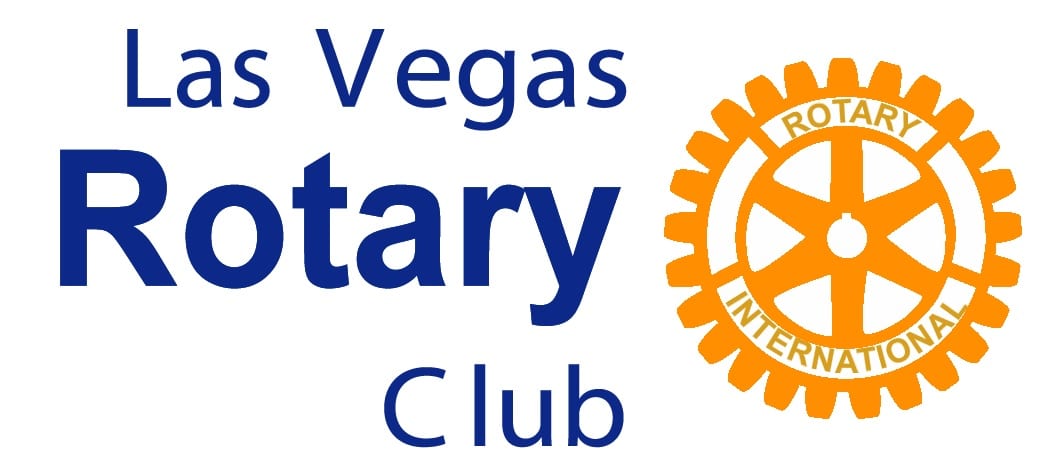1923 - 1940
In the beginning....It was 1923, and Las Vegas was slowly emerging from a crippling railroad strike, which hit the community in 1922 and almost wrecked, the town’s economy. On April 5 of that year, Rotary was born.
Les Saunders, who came here from Southern California to take over as manager of the Chamber of Commerce, sowed the seed. Seventeen others joined him to form the club’s charter membership.
The charter members were Dr. William S. Park, the only dentist in town at the time; A.A. Hinman, a lawyer; Walter Bracken, Union Pacific representative; C.E. “Pem” Pembroke, a merchant; Harry Blanding, a butcher and owner of a large “ranch’ on West Charleston where the Presbyterian Church now stands; William H. “Bill” Pike, founder of the Cragin and Pike Insurance Company and owner of the only theater in town; Bill Ferron, pioneer pharmacist; W.S. German, Union Pacific employee and former city commissioner; Cyril S. Wengert, banker; James Cashman, auto dealer; Dr. Roy W. Martin, pioneer physician and surgeon; Jack Heaton, an employee of the Union Pacific; Bill Beckley, haberdasher, Ed W. Clark, banker; Sam J. Lawson, power and telephone company; O. K. Adcock, haberdasher; and Mel Riley, real estate man.
At that time Las Vegas was a sleepy railroad town. Moving along Fremont Street from the Union Pacific Depot, you would run out of town when you reached Fifth Street. The block from Fourth to Fifth, on both sides of the street, was occupied by the then elaborate homes of the Ferrons, the Brackens, the McNamees, the Squires, the Norrises, and several more whose names have been erased by the ravages of time.
There was no glamour along the street such as there is now. Where the Golden Nugget now stands, on the corner of Second and Fremont, was the E.W. Griffith Building, which housed the post office and a hotel upstairs. Next door to the post office was the Majestic Theater owned by Pike. Across the street, the site of the present Horseshoe Club was a vacant lot with the remains of an old foundation covered over with willows. Where the Fremont now stands was another vacant lot, and on the southeast corner Bill Ferron owned the White Cross Drug Store, with the telephone and power company office in the real on Second Street, and Dr. Park’s office on the second floor.
The business district started fading into residential area about midway between Third and Fourth. The cross streets between Ogden and Bridger were all residential. Third and Fourth Streets were occupied mostly by “company” houses, the Union Pacific having built them for their employees prior to the strike.
The Rotary club actually was formed on February 23, 1923. The founders met in the Chocolate Shop at 203 Fremont, which now is a part of the Golden Nugget. The Rotary Club of Las Vegas was chartered on April 5 and designated as Club Number 1401 of becoming the first baby Rotarian fell to C.P. “Pop” Squires. “Pop” was the Las Vegas Postmaster and also publisher of the Las Vegas Age. He was the editor of The Wheel for some 30 years, and in his later years was made a special honorary member for life for his outstanding and unselfish service to the club and the community.
The Las Vegas Rotary Club won its first honor and distinction by attending three district assemblies (San Jose in 1924, Fresno in 1925, and San Diego in 1926) with 100 percent in attendance. To those in the membership today, that may not appear to be much of an accomplishment. However, in 1924, ’25, and ’26, it was considered quite a feat.
During the 20’s, there were no paved highways from here to anywhere. Dirt roads, rut-filled and dusty, moved out of Las Vegas in two directions – north and south to Los Angeles and Salt Lake City. A trip to Reno by car was almost unheard of, and the road to Needles and Kingman was not much better. There was no Boulder City, nor Henderson. Las Vegas was practically isolated. Anyone needing to go anywhere went by train. A few hardy souls risked the rigors of the desert by car, but their friends at home considered them real daredevils.
Shortly after the club was formed, the Chocolate Shop closed, and the meetings were moved to the “Beanery”, the Union Pacific dining room just north of the present station. The Beanery was about the only place in town to eat satisfactorily, and even then, some days, the food was pretty bad. It is strange commentary that today Las Vegas is considered one of the gourmet’s delight, for back in the 20’s & 30’s, one hardly could find a satisfactory place to eat in town.
The next meeting place was forced on the club by
progress. It came about in 1938 when the
Beanery was torn down to make way for the new and modern depot. So the club picked up its knives and forks
and moved to the Kiva Club. This
establishment was in the basement of the Apache Hotel, built by P.O.
Silvagni on that vacant lot where the foundation and the willows were back
at the beginning of the club.
